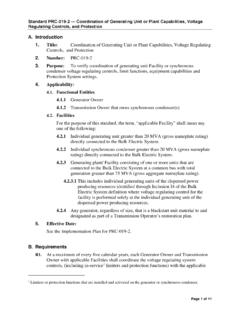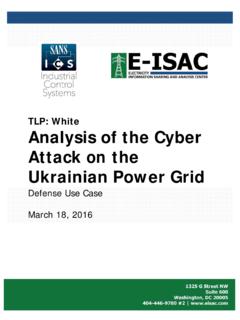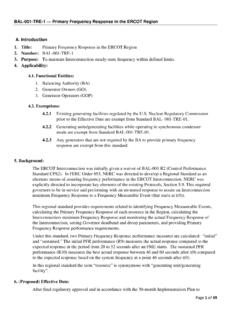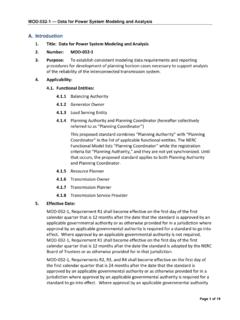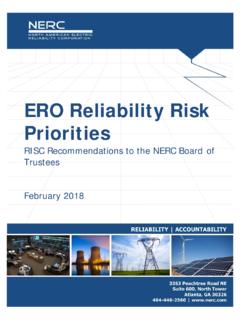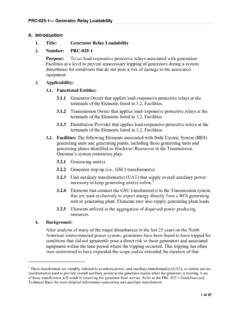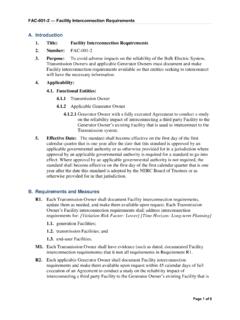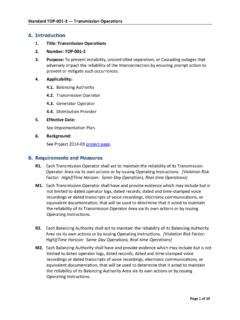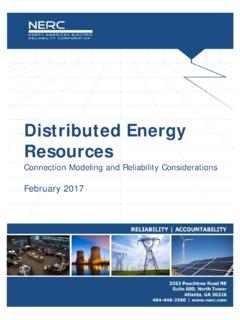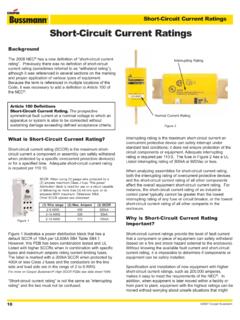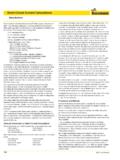Transcription of or as otherwise made effective pursuant to the laws ...
1 Standard TPL-001-4 Transmission System Planning Performance Requirements 1 A. Introduction 1. Title: Transmission System Planning Performance Requirements 2. Number: TPL-001-4 3. Purpose: Establish Transmission system planning performance requirements within the planning horizon to develop a Bulk Electric System (BES) that will operate reliably over a broad spectrum of System conditions and following a wide range of probable Contingencies. 4. Applicability: Functional Entity Planning Coordinator. Transmission Planner. 5. effective Date: Requirements R1 and R7 as well as the definitions shall become effective on the first day of the first calendar quarter, 12 months after applicable regulatory approval. In those jurisdictions where regulatory approval is not required, Requirements R1 and R7 become effective on the first day of the first calendar quarter, 12 months after Board of Trustees adoption or as otherwise made effective pursuant to the laws applicable to such ERO governmental authorities.
2 Except as indicated below, Requirements R2 through R6 and Requirement R8 shall become effective on the first day of the first calendar quarter, 24 months after applicable regulatory approval. In those jurisdictions where regulatory approval is not required, all requirements, except as noted below, go into effect on the first day of the first calendar quarter, 24 months after Board of Trustees adoption or as otherwise made effective pursuant to the laws applicable to such ERO governmental authorities. For 84 calendar months beginning the first day of the first calendar quarter following applicable regulatory approval, or in those jurisdictions where regulatory approval is not required on the first day of the first calendar quarter 84 months after Board of Trustees adoption or as otherwise made effective pursuant to the laws applicable to such ERO governmental authorities, Corrective Action Plans applying to the following categories of Contingencies and events identified in TPL-001-4, Table 1 are allowed to include Non-Consequential Load Loss and curtailment of Firm Transmission Service (in accordance with Requirement R2, Part ) that would not otherwise be permitted by the requirements of TPL-001-4.
3 P1-2 (for controlled interruption of electric supply to local network customers connected to or supplied by the Faulted element) P1-3 (for controlled interruption of electric supply to local network customers connected to or supplied by the Faulted element) P2-1 P2-2 (above 300 kV) P2-3 (above 300 kV) P3-1 through P3-5 P4-1 through P4-5 (above 300 kV) P5 (above 300 kV) Standard TPL-001-4 Transmission System Planning Performance Requirements 2 B. Requirements R1. Each Transmission Planner and Planning Coordinator shall maintain System models within its respective area for performing the studies needed to complete its Planning Assessment. The models shall use data consistent with that provided in accordance with the MOD-010 and MOD-012 standards, supplemented by other sources as needed, including items represented in the Corrective Action Plan, and shall represent projected System conditions. This establishes Category P0 as the normal System condition in Table 1.
4 [Violation Risk Factor: High] [Time Horizon: Long-term Planning] System models shall represent: Existing Facilities Known outage(s) of generation or Transmission Facility(ies) with a duration of at least six months. New planned Facilities and changes to existing Facilities Real and reactive Load forecasts Known commitments for Firm Transmission Service and Interchange Resources (supply or demand side) required for Load R2. Each Transmission Planner and Planning Coordinator shall prepare an annual Planning Assessment of its portion of the BES. This Planning Assessment shall use current or qualified past studies (as indicated in Requirement R2, Part ), document assumptions, and document summarized results of the steady state analyses, short circuit analyses, and Stability analyses. [Violation Risk Factor: High] [Time Horizon: Long-term Planning] For the Planning Assessment, the Near-Term Transmission Planning Horizon portion of the steady state analysis shall be assessed annually and be supported by current annual studies or qualified past studies as indicated in Requirement R2, Part Qualifying studies need to include the following conditions: System peak Load for either Year One or year two, and for year five.
5 System Off-Peak Load for one of the five years. P1 events in Table 1, with known outages modeled as in Requirement R1, Part , under those System peak or Off-Peak conditions when known outages are scheduled. For each of the studies described in Requirement R2, Parts and , sensitivity case(s) shall be utilized to demonstrate the impact of changes to the basic assumptions used in the model. To accomplish this, the sensitivity analysis in the Planning Assessment must vary one or more of the following conditions by a sufficient amount to stress the System within a range of credible conditions that demonstrate a measurable change in System response : Real and reactive forecasted Load. Expected transfers. Expected in service dates of new or modified Transmission Facilities. Reactive resource capability. Generation additions, retirements, or other dispatch scenarios. Standard TPL-001-4 Transmission System Planning Performance Requirements 3 Controllable Loads and Demand Side Management.
6 Duration or timing of known Transmission outages. When an entity s spare equipment strategy could result in the unavailability of major Transmission equipment that has a lead time of one year or more (such as a transformer), the impact of this possible unavailability on System performance shall be studied. The studies shall be performed for the P0, P1, and P2 categories identified in Table 1 with the conditions that the System is expected to experience during the possible unavailability of the long lead time equipment . For the Planning Assessment, the Long-Term Transmission Planning Horizon portion of the steady state analysis shall be assessed annually and be supported by the following annual current study, supplemented with qualified past studies as indicated in Requirement R2, Part : A current study assessing expected System peak Load conditions for one of the years in the Long-Term Transmission Planning Horizon and the rationale for why that year was selected.
7 The short circuit analysis portion of the Planning Assessment shall be conducted annually addressing the Near-Term Transmission Planning Horizon and can be supported by current or past studies as qualified in Requirement R2, Part The analysis shall be used to determine whether circuit breakers have interrupting capability for Faults that they will be expected to interrupt using the System short circuit model with any planned generation and Transmission Facilities in service which could impact the study area. For the Planning Assessment, the Near-Term Transmission Planning Horizon portion of the Stability analysis shall be assessed annually and be supported by current or past studies as qualified in Requirement R2, The following studies are required: System peak Load for one of the five years. System peak Load levels shall include a Load model which represents the expected dynamic behavior of Loads that could impact the study area, considering the behavior of induction motor Loads.
8 An aggregate System Load model which represents the overall dynamic behavior of the Load is acceptable. System Off-Peak Load for one of the five years. For each of the studies described in Requirement R2, Parts and , sensitivity case(s) shall be utilized to demonstrate the impact of changes to the basic assumptions used in the model. To accomplish this, the sensitivity analysis in the Planning Assessment must vary one or more of the following conditions by a sufficient amount to stress the System within a range of credible conditions that demonstrate a measurable change in performance: Load level, Load forecast, or dynamic Load model assumptions. Expected transfers. Expected in service dates of new or modified Transmission Facilities. Reactive resource capability. Generation additions, retirements, or other dispatch scenarios. Standard TPL-001-4 Transmission System Planning Performance Requirements 4 For the Planning Assessment, the Long-Term Transmission Planning Horizon portion of the Stability analysis shall be assessed to address the impact of proposed material generation additions or changes in that timeframe and be supported by current or past studies as qualified in Requirement R2, and shall include documentation to support the technical rationale for determining material changes.
9 Past studies may be used to support the Planning Assessment if they meet the following requirements: For steady state, short circuit, or Stability analysis: the study shall be five calendar years old or less, unless a technical rationale can be provided to demonstrate that the results of an older study are still valid. For steady state, short circuit, or Stability analysis: no material changes have occurred to the System represented in the study. Documentation to support the technical rationale for determining material changes shall be included. For planning events shown in Table 1, when the analysis indicates an inability of the System to meet the performance requirements in Table 1, the Planning Assessment shall include Corrective Action Plan(s) addressing how the performance requirements will be met. Revisions to the Corrective Action Plan(s) are allowed in subsequent Planning Assessments but the planned System shall continue to meet the performance requirements in Table 1.
10 Corrective Action Plan(s) do not need to be developed solely to meet the performance requirements for a single sensitivity case analyzed in accordance with Requirements R2, Parts and The Corrective Action Plan(s) shall: List System deficiencies and the associated actions needed to achieve required System performance. Examples of such actions include: Installation, modification, retirement, or removal of Transmission and generation Facilities and any associated equipment . Installation, modification, or removal of Protection Systems or Special Protection Systems Installation or modification of automatic generation tripping as a response to a single or multiple Contingency to mitigate Stability performance violations. Installation or modification of manual and automatic generation runback/tripping as a response to a single or multiple Contingency to mitigate steady state performance violations. Use of Operating Procedures specifying how long they will be needed as part of the Corrective Action Plan.
